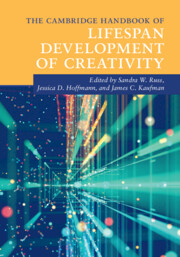Book contents
- The Cambridge Handbook of Lifespan Development of Creativity
- The Cambridge Handbook of Lifespan Development of Creativity
- Copyright page
- Dedication
- Contents
- Figures
- Tables
- Contributors
- Acknowledgments
- Introduction
- Part I Core Concepts of Lifespan Creativity Development
- Part II The Development of Creativity
- Part III Modes of Enhancement
- Part IV Environments and Contexts
- Part V Special Populations
- 23 The Development of Gifted and Talented Students’ Creativity in School Contexts
- 24 Creative Play in Children with Neurodevelopmental Disorders
- 25 Eminent Creators
- Epilogue: What Have We Learned?
- Index
- References
25 - Eminent Creators
Early Experiences and Adult Achievement
from Part V - Special Populations
Published online by Cambridge University Press: 19 November 2021
- The Cambridge Handbook of Lifespan Development of Creativity
- The Cambridge Handbook of Lifespan Development of Creativity
- Copyright page
- Dedication
- Contents
- Figures
- Tables
- Contributors
- Acknowledgments
- Introduction
- Part I Core Concepts of Lifespan Creativity Development
- Part II The Development of Creativity
- Part III Modes of Enhancement
- Part IV Environments and Contexts
- Part V Special Populations
- 23 The Development of Gifted and Talented Students’ Creativity in School Contexts
- 24 Creative Play in Children with Neurodevelopmental Disorders
- 25 Eminent Creators
- Epilogue: What Have We Learned?
- Index
- References
Summary
This chapter treats the life-span development of creative genius. The treatment is divided into three main sections. First, developmental experiences in childhood and adolescence are examined, with special focus on family background and education or training. Second, adulthood career trajectories are discussed, including such issues as output quantity and quality in creative products. Third, discussion turns to career termination, with special emphasis on the differential life expectancies of creators attaining eminence in different domains. The chapter concludes by addressing the question of whether creative development in the highly eminent is comparable to that seen in more everyday forms of creativity. Although some similarities are apparent, congruence cannot be assumed without considerably more research on both extremes of the phenomenon.
- Type
- Chapter
- Information
- The Cambridge Handbook of Lifespan Development of Creativity , pp. 530 - 551Publisher: Cambridge University PressPrint publication year: 2021
References
- 1
- Cited by



